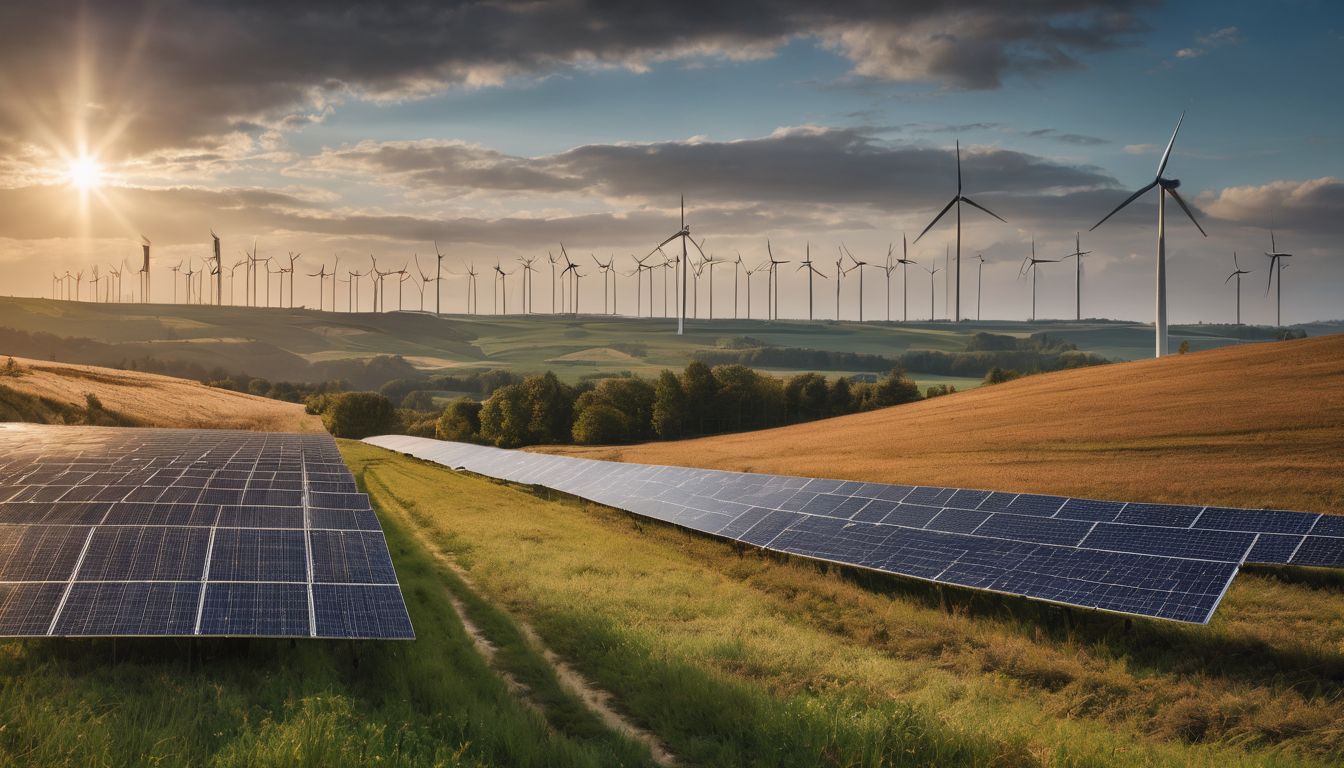Struggling to understand your electricity bill? Appliances at home could be the culprits, stealthily guzzling energy. This post demystifies energy ratings, empowering you to choose wiser and save cash.
Jump in for savvy tips!
Key Takeaways
- ENERGY STAR products save energy and costs as they consume 10-50% less power than standard models. Look for the blue label to identify these on shelves.
- Use the EnergyGuide label to compare annual energy use and cost between appliances, choosing those with lower kWh numbers for greater savings.
- With changing energy ratings, stay informed about new efficient technologies; remember government incentives can help afford eco-friendly upgrades.
- Consider proper disposal of old appliances through recycling or take – back programmes to prevent environmental harm.
- Factor in your home’s size, usage patterns, and desired appliance features when evaluating energy efficiency for long-term benefits.
What Makes a Product ENERGY STAR?
A product earns the ENERGY STAR label by meeting strict energy efficiency guidelines set out by a respective environmental agency. Manufacturers must prove their appliances use less energy than standard models, often through third-party testing and verification.
These products contribute to significant electricity bill savings while bolstering efforts in conservation and environmental protection.
They also help reduce greenhouse gas emissions, making them a smart choice for eco-friendly consumers looking to minimise their carbon footprint. An ENERGY STAR certified appliance incorporates advanced technologies that use 10-50% less energy and water than conventional ones.
It’s an immediate signal that the user is purchasing a product designed for optimal energy performance without sacrificing functionality or features.
Shoppers can easily identify these superior performers on shelves as they carry the distinctive blue label that sets them apart from others. Now let’s explore how consumers can utilise EnergyGuide labels to make informed decisions about their household purchases.
How to Use the EnergyGuide Label for Shopping
Understanding the energy consumption of appliances is essential when shopping for new ones. The EnergyGuide label provides valuable information to compare energy usage and identify ENERGY STAR products.
Understanding energy consumption
Energy consumption refers to the amount of energy used by a specific appliance or electronic device. By looking at the EnergyGuide label, consumers can compare the estimated annual energy consumption and operating costs of different models when shopping for new appliances.
This allows individuals to make informed decisions about which products are more energy-efficient and environmentally friendly. When comparing similar models, it’s essential to consider not just the purchase price but also the long-term running costs associated with their energy use.
Comparing energy usage with similar models helps consumers identify ENERGY STAR products that meet strict efficiency guidelines set by the Environmental Protection Agency (EPA). These appliances not only consume less energy but also help reduce utility bills while minimising environmental impact, making them an excellent choice for those seeking to lower their household’s energy consumption.
Comparing energy usage with similar models
When shopping for new appliances, it’s vital to compare energy usage across different models to ensure you’re making an environmentally friendly choice. Review the energy consumption data, typically measured in kilowatt-hours (kWh), to assess which appliance will cost less to operate and have a smaller carbon footprint.
| Appliance Type | Model | Annual Energy Use (kWh) | Estimated Annual Cost (£) |
|---|---|---|---|
| Refrigerator | Model A | 350 kWh | 45 |
| Model B | 400 kWh | 52 | |
| Washing Machine | Model C | 270 kWh | 35 |
| Model D | 230 kWh | 30 | |
| Dishwasher | Model E | 280 kWh | 36 |
| Model F | 300 kWh | 39 |
Select models that show lower kWh numbers and estimated costs. These appliances will typically use less energy and be more cost-effective to operate. Opting for these options can significantly reduce your energy bill and environmental impact.
Identifying ENERGY STAR products
When comparing energy usage with similar models, it’s essential to look for the ENERGY STAR label when shopping for appliances. The ENERGY STAR logo signifies that the product meets specific energy efficiency guidelines set by the Environmental Protection Agency and the Department of Energy.
By choosing ENERGY STAR products, you can enjoy lower energy costs while reducing your environmental impact. Look for this symbol on a wide range of household appliances such as refrigerators, washing machines, air conditioners, and more to make environmentally friendly choices and save on energy bills.
To identify ENERGY STAR products readily, simply keep an eye out for the distinct blue label wherever you shop for new appliances; its presence guarantees significant savings in both electricity consumption and money spent over time without compromising appliance performance or quality.
Benefits of Energy Efficient Appliances
Save money on your energy bills, reduce your environmental impact and enjoy the benefits of more eco-friendly appliances. Learn more about how you can make a positive impact by understanding energy ratings on appliances.
Lower energy costs
Energy-efficient appliances can significantly reduce your energy costs over time. By opting for products with high ENERGY STAR ratings and EnergyGuide labels, you can make a positive impact on both the environment and your wallet.
These labels provide valuable information about the estimated annual energy consumption of an appliance, allowing you to choose models that are more efficient and cost-effective in the long run.
Investing in energy-efficient electronics not only lowers your utility bills but also contributes to reducing carbon emissions and promoting sustainability. When comparing similar models using these energy labels, opt for those with lower energy usage as indicated on the label to achieve significant savings.
Reduced environmental impact
Energy-efficient appliances play a significant role in reducing environmental impact. By consuming less energy, these products help lower overall greenhouse gas emissions from power plants.
This results in cleaner air and contributes to the preservation of natural resources.
Choosing ENERGY STAR-rated appliances is a simple yet effective way to reduce your carbon footprint. A range of eco-friendly options are available across various categories, such as refrigerators, washing machines, and air conditioners.
By opting for these energy-saving solutions, individuals can actively participate in environmental conservation efforts while enjoying the benefits of efficient home appliances.
Understanding Energy Labels
The EnergyGuide label provides important information about an appliance’s energy consumption and efficiency, helping consumers make informed decisions when shopping for new products.
To learn more about how to use this label effectively, continue reading our blog!
What information is provided
The EnergyGuide label provides key information about an appliance’s energy consumption, helping consumers make informed decisions. It includes the estimated yearly electricity usage and cost, allowing for easy comparison between models.
Additionally, the label indicates if a product meets ENERGY STAR qualifications, highlighting environmentally friendly options.
Changes in energy ratings are also displayed to keep consumers updated on current efficiency standards. Beyond electricity consumption, the label may include additional factors such as water usage or noise levels to consider when making a purchase decision.
Changes in energy ratings
Energy ratings are continually evolving to reflect advancements in energy-saving technologies and the changing environmental landscape. Manufacturers are constantly improving their products to meet new energy efficiency standards, leading to changes in energy ratings across different appliances.
Understanding these changes is crucial for consumers looking to make informed decisions about their purchases and minimise their environmental impact.
As newer, more efficient models enter the market, older appliances may see a decrease in their energy ratings when compared to the latest options. This means that what was once considered an energy-efficient product might no longer meet the same standard as newer alternatives.
Additional factors to consider
When looking at energy ratings on appliances, it’s important to consider the size and layout of your home. Larger homes may require more energy-efficient appliances, whereas smaller spaces might not need as high a rating to achieve savings.
Furthermore, usage patterns can affect energy efficiency; for instance, if an appliance is used frequently throughout the day, a higher-rated model may be necessary.
Additionally, it’s crucial to take into account any special features or additional functions you need from an appliance. Some advanced features might increase initial costs but could lead to long-term energy savings.
Further Actions for Improving Energy Efficiency
Proper disposal of old appliances is crucial for reducing environmental impact, staying informed on energy-saving technologies can help you make the best choices for your home, and taking advantage of government incentives can save you money while promoting energy efficiency.
Proper disposal of old appliances
When disposing of old appliances, consider recycling options to reduce environmental impact. Check with local waste management authorities for designated collection points or recycling facilities.
Many manufacturers also offer take-back programmes, ensuring that your old appliance is disposed of in an environmentally friendly manner according to regulations, preventing harmful substances from entering the environment.
Remember to remove any hazardous materials such as refrigerants and ensure that the appliance is properly drained before disposal. Keeping these principles in mind not only supports environmental conservation but also promotes responsible waste management, contributing to a greener and healthier planet.
Staying informed on energy-saving technologies
Stay updated on energy-saving technologies to make informed decisions about your home appliances. Keep an eye out for new developments in eco-friendly products, such as smart thermostats and energy-efficient lighting options.
Explore government incentives or rebates that can make these upgrades more affordable for you.
By staying informed, you stay ahead of the curve in reducing your environmental footprint and cutting down on energy costs. Continuously educating yourself about the latest advancements helps ensure that your home is equipped with the most efficient and environmentally friendly options available.
Taking advantage of government incentives.
To maximise savings, explore government incentives for energy-efficient appliance purchases. Check your local and national programmes for rebates or tax credits linked to ENERGY STAR products.
These incentives can significantly reduce initial costs while promoting sustainability.
Conclusion
Understanding energy ratings on appliances is crucial for making informed purchasing decisions. The EnergyGuide label provides valuable information to compare energy usage between models, and identifying ENERGY STAR products can lead to significant cost savings.
By understanding the benefits of energy-efficient appliances and staying informed about industry changes, we can all play a part in conserving energy and protecting the environment.
Taking further actions such as proper disposal of old appliances and taking advantage of government incentives will contribute to a sustainable future.
FAQs
1. What are energy ratings on appliances?
Energy ratings on appliances tell you how energy efficient a product is, with the energy guide label showing if an appliance will save electricity and be eco-friendly.
2. Why should I compare energy ratings when buying electronics?
Comparing energy ratings helps you choose the most energy-efficient electronics which can save money and help in energy conservation.
3. Can understanding energy ratings affect the environment?
Yes, by choosing appliances with better energy rating labels, you support environmental friendliness as these products use less power and reduce carbon emissions.
4. How does the Energy Guide rating system work for appliances?
The Energy Guide rating system ranks appliances based on their efficiency; an easy-to-read label shows how much electricity an appliance uses and compares it to similar models.





